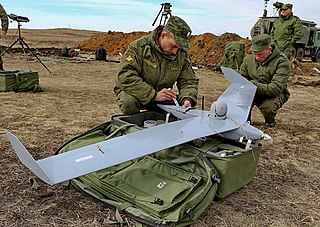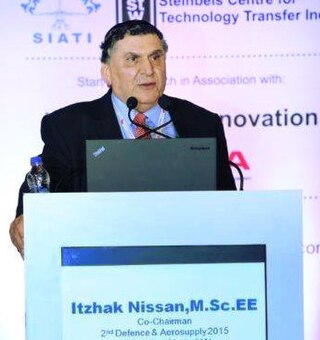
Israel Aerospace Industries or IAI (תע"א) is Israel's major aerospace and aviation manufacturer, producing aerial and astronautic systems for both military and civilian usage. It has 15,000 employees as of 2018. IAI is state-owned by the government of Israel.

The IAI Heron (Machatz-1) is a medium-altitude long-endurance unmanned aerial vehicle (UAV) developed by the Malat (UAV) division of Israel Aerospace Industries. It is capable of Medium Altitude Long Endurance (MALE) operations of up to 52 hours' duration at up to 10.5 km (35,000 ft). It has demonstrated 52 hours of continuous flight, but the effective operational maximal flight duration is less, according to payload and flight profile. An advanced version, the Heron TP, is also known as the IAI Eitan.

RANGER is a tactical UAV system (TUAV) built as a Swiss-Israeli joint venture between Swiss aerospace enterprise RUAG Aviation and Israeli aerospace company Israel Aerospace Industries. Its design and some of its technology is based on the Scout UAV system by Israel Aerospace Industries.

The LAHAT is a third generation semi-active laser homing guided low-weight anti-tank guided missile developed since 1991 and manufactured by Israel Aerospace Industries. It has a tandem-charge high-explosive anti-tank (HEAT) warhead. It was designed primarily to be fired by Merkava tanks' 105 mm and 120 mm tank guns, though it matches all types of 105 mm and 120 mm guns, including low recoil guns and low-weight guns of military armoured cars.

LORA is a theater quasi-ballistic missile developed by Israel Aerospace Industries (IAI). The missile has a range of 400 kilometres (250 mi) and a CEP of 10 metres (33 ft) when using a combination of GPS and TV for terminal guidance. It can be ship-launched from inside of a standard Intermodal container as well as land-launched.

Skytran is a personal rapid transit system concept. It was first proposed by inventor Douglas Malewicki in 1990, and is under development by Unimodal Inc. A prototype of the skyTran vehicle and a section of track have been constructed. The early magnetic levitation system, Inductrack, which SkyTran has replaced with a similar proprietary design, has been tested by General Atomics with a full-scale model. In 2010, Unimodal signed an agreement with NASA to test and develop skyTran. skyTran has proposed additional projects in France, Germany, India, Indonesia, Malaysia, the United Kingdom, and the United States.

IAI Bird-Eye is a family of mini-UAVs developed by Israel Aerospace Industries (IAI) Malat division. Designed for military and paramilitary intelligence, surveillance and reconnaissance missions.

Barak 8, also known as LR-SAM or MR-SAM, is an Indo-Israeli jointly developed surface-to-air missile (SAM) system, designed to defend against any type of airborne threat including aircraft, helicopters, anti-ship missiles, and UAVs as well as ballistic missiles, cruise missiles and combat jets. Both maritime and land-based variants of the system exist.

AMOS-6 was an Israeli communications satellite, one of the Spacecom AMOS series, that was built by Israel Aerospace Industries (IAI), a defense and aerospace company.

The Arrow 3 or Hetz 3 is an exoatmospheric hypersonic anti-ballistic missile, jointly funded, developed and produced by Israel and the United States. Undertaken by Israel Aerospace Industries (IAI) and Boeing, it is overseen by the Israeli Ministry of Defense's "Homa" administration and the U.S. Missile Defense Agency. It provides exo-atmospheric interception of ballistic missiles, including intercontinental ballistic missiles (ICBMs) carrying nuclear, chemical, biological or conventional warheads. With divert motor capability, its kill vehicle can switch directions dramatically, allowing it to pivot to see approaching satellites. The missile's reported flight range is up to 2,400 km (1,500 mi).
IAI-HAL NRUAV is a rotorcraft project being co-developed by Malat Solutions, a unit of IAI of Israel, and HAL of India for the Indian Navy.

SpaceIL is an Israeli organization, established in 2011, that competed in the Google Lunar X Prize (GLXP) contest to land a spacecraft on the Moon.
The IAI Ghost is a reconnaissance mini unmanned air vehicle developed in Israel by Israel Aircraft Industries. It is the second tandem-rotor UAV developed by IAI after IAI Panther.

The ELM-2084 is an Israeli ground-based mobile 3D AESA multi-mission radar (MMR) family produced by ELTA, a subsidiary of Israel Aerospace Industries.

Itzhak Nissan is an Israeli engineer and business executive who is the chairman and CEO of Meteor Aerospace Ltd., a privately owned Israeli defense and security company that Nissan founded.

The IAI Rotem L or IAI Rotem - Light is a loitering munition developed by the Israel Aerospace Industries. The drone is a quadcopter that can loiter for 30–45 minutes with the maximum range of 10 km. It can carry 1 kg warhead that could be two fragmentation grenades.
The EL/M-2090 TERRA is an Israeli ground-based very long range early-warning radar system produced by Elta, a subsidiary of Israel Aerospace Industries IAI. It is composed of 2 radars: the UHF Ultra and the S band SPECTRA. TERRA's performance is achieved through automatic handover and redundancy between the ULTRA and SPECTRA radars, combined with improved target load sharing, Electronic counter-countermeasures (ECCM) and severe-weather resilience. The system can be used for ballistic missiles and space objects detection and tracking at very long ranges.
TopGun is an add-on guidance kit that converts standard artillery ammunition into a precision guided weapon. It is manufactured by Israel Aerospace Industries. It uses a GPS receiver to adjust the trajectory of the shell in flight with a circular error probable (CEP) of 10 m at up to 40 km with a unit cost of US$20,000. In use by Israeli Army.

Beresheet was a demonstrator of a small robotic lunar lander and lunar probe operated by SpaceIL and Israel Aerospace Industries. Its aims included inspiring youth and promoting careers in science, technology, engineering, and mathematics (STEM), and landing its magnetometer, time capsule, and laser retroreflector on the Moon. The lander's gyroscopes failed on 11 April 2019 causing the main engine to shut off, which resulted in the lander crashing on the Moon. Its final resting position is 32.5956°N, 19.3496°E.
The Unmanned Underwater Vehicle (UUV) from Israeli manufacturer ELTA Systems Ltd. is used to gather information using radar, SIGINT and communications technologies.














